
This is a small group of red and yellow yuccas that I found at a roadside pull off.
To most men , experience is like the stern light of a ship which il-luminates only the track it has passed. (Samuel Tylor Coleridge, British poet)
 Ahhhh...we are back "home". Or at least our "winter home". We are so happy to be here!
Ahhhh...we are back "home". Or at least our "winter home". We are so happy to be here!















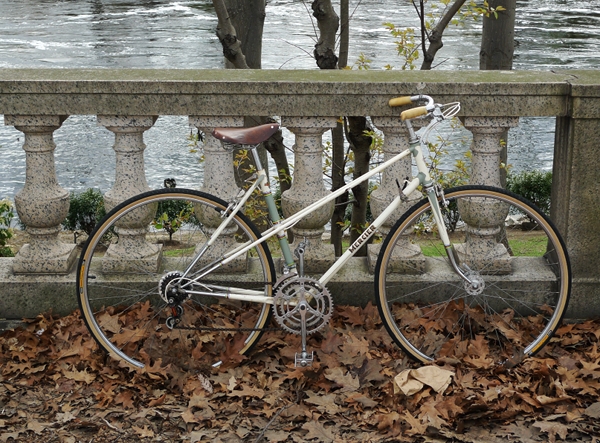 Can you spot the differences between this picture and the Mercier in its initial state?
Can you spot the differences between this picture and the Mercier in its initial state?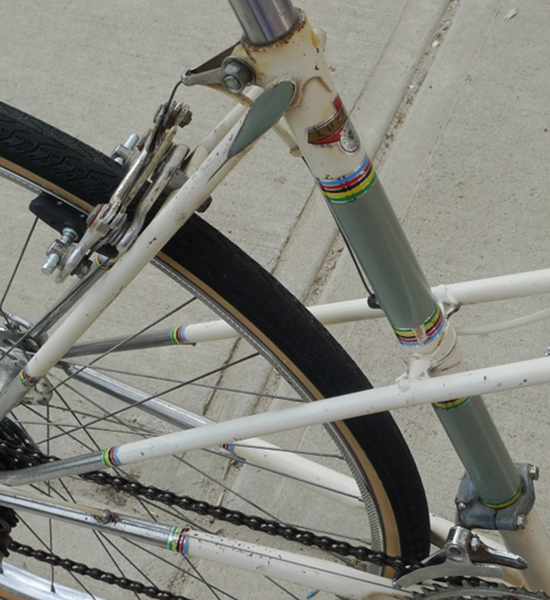 If you are thinking that the colour scheme looks a bit different, you are right. Originally, the Mercier had black lugwork and paneling - but to my eye, this created too harsh of a contrast with the cream frame. It also had the effect of stopping the eye at the frame's joints and making the bicycle look "choppy", whereas I like mixtes to have an elongated, fluid look to them. So after considering my options, I bought some enamel paint and hand-painted over the black lugwork and panels. The new colour is a light green-gray; very French and Spring-like. I have yet to redo the gold pinstriping around the edges, but from a distance it looks passable as is.
If you are thinking that the colour scheme looks a bit different, you are right. Originally, the Mercier had black lugwork and paneling - but to my eye, this created too harsh of a contrast with the cream frame. It also had the effect of stopping the eye at the frame's joints and making the bicycle look "choppy", whereas I like mixtes to have an elongated, fluid look to them. So after considering my options, I bought some enamel paint and hand-painted over the black lugwork and panels. The new colour is a light green-gray; very French and Spring-like. I have yet to redo the gold pinstriping around the edges, but from a distance it looks passable as is.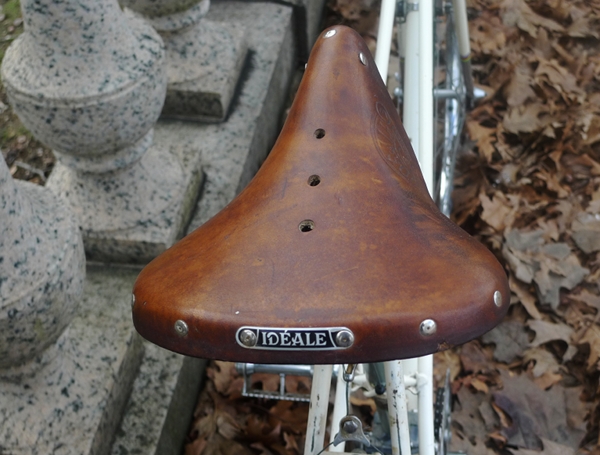 Another visible update to the Mercier is this fantastic Ideale saddle - acquired in a trade with a Lovely Bicycle reader (thank you!).
Another visible update to the Mercier is this fantastic Ideale saddle - acquired in a trade with a Lovely Bicycle reader (thank you!).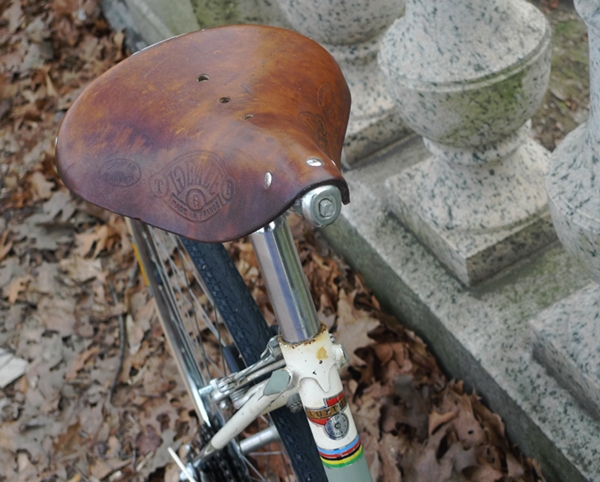 Ideale saddles are French, and described in this interesting article as "celebrated and enigmatic". This one is a Model 6, which is a short-nosed women's model from the 1970's.
Ideale saddles are French, and described in this interesting article as "celebrated and enigmatic". This one is a Model 6, which is a short-nosed women's model from the 1970's.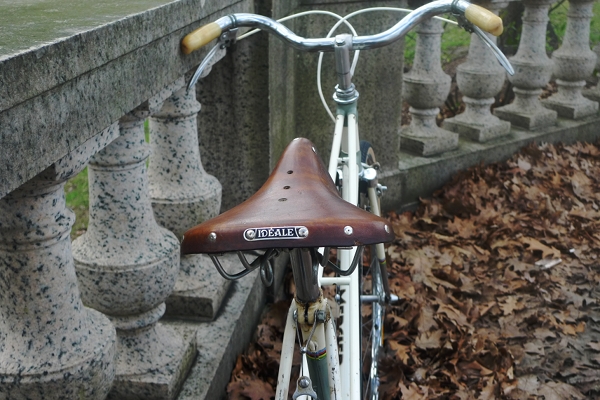 It is comparable to a Brook's B72S and has two rear loop springs.
It is comparable to a Brook's B72S and has two rear loop springs.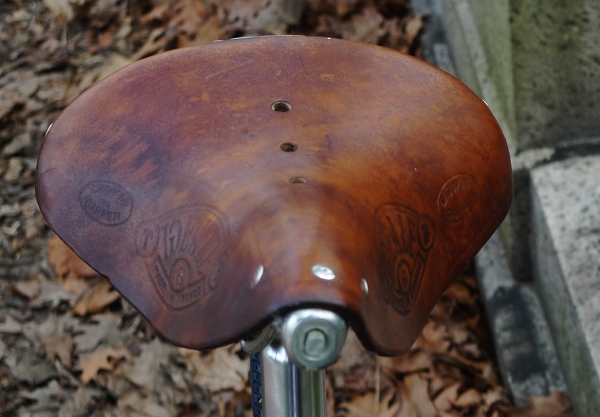 An extremely comfortable, elegant saddle. And the engraving is gorgeous. I have cycled a total of maybe 50 miles on it so far and it feels just perfect.
An extremely comfortable, elegant saddle. And the engraving is gorgeous. I have cycled a total of maybe 50 miles on it so far and it feels just perfect.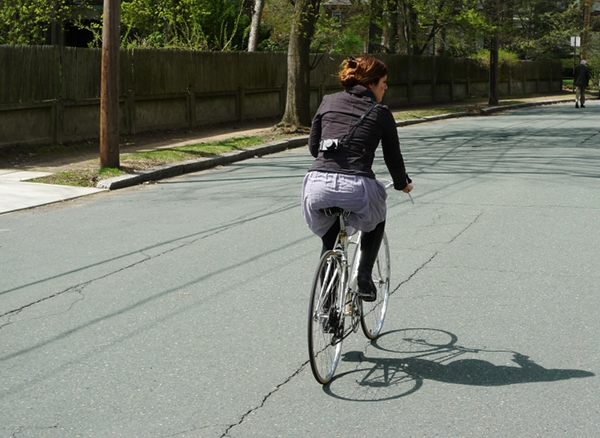 The last significant update has been replacing the tires. The shop where I found the bike fitted it with 20mm racing tires. To give you a point of reference, 20mm is narrower than the wheel rims. I think the fact that I was even able to ride on these tires at all - let alone 10 miles to Harris Cyclery to get new tires - is a testament to how stable and comfortable the Mercier is. The only problem I had, was with cracks in the road: 20mm tires are narrow enough to get stuck in the most innocent-looking cracks! After this happened to me once and I almost got knocked off the bike, I became hyper-vigilant.
The last significant update has been replacing the tires. The shop where I found the bike fitted it with 20mm racing tires. To give you a point of reference, 20mm is narrower than the wheel rims. I think the fact that I was even able to ride on these tires at all - let alone 10 miles to Harris Cyclery to get new tires - is a testament to how stable and comfortable the Mercier is. The only problem I had, was with cracks in the road: 20mm tires are narrow enough to get stuck in the most innocent-looking cracks! After this happened to me once and I almost got knocked off the bike, I became hyper-vigilant. Thankfully, now the bicycle is fitted with 32mm Panaracer Pasela Tourguards - a beautiful vintage-looking tire with tan walls and superb puncture protection (These are the same tires I have on Marianne, and I have been very happy with them over the past year).
Thankfully, now the bicycle is fitted with 32mm Panaracer Pasela Tourguards - a beautiful vintage-looking tire with tan walls and superb puncture protection (These are the same tires I have on Marianne, and I have been very happy with them over the past year).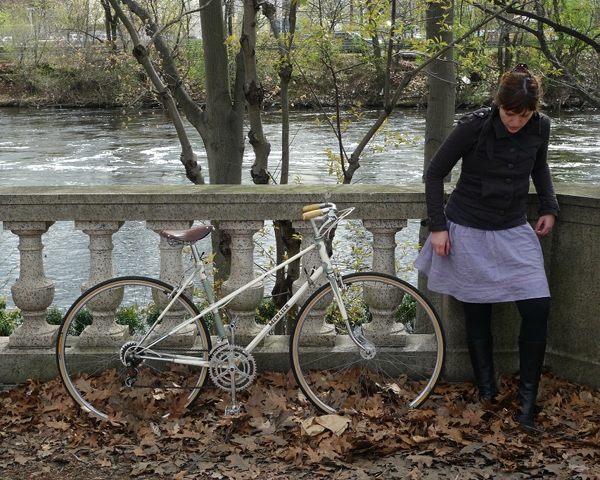 In addition to these updates, there are other little things we've done, like remove the spoke protector and the reflectors from the wheels, remove the Pletscher rack (which did not look right on this bike), clean the handlebar grips, and replace the black tape used to patch up a crack in the white cable housing with white tape, making it less visible. Future updates will include a set of inexpensive fenders from Velo Orange, a vintage front rack, and switching the downtube shifters to a set of old stem-mounted ones. So far, the only new components or accessories I have bought for this bike have been the tires. Everything else has been vintage, and for the most part acquired in a trade. I think I will try to do the same with future updates. Will see where this goes!
In addition to these updates, there are other little things we've done, like remove the spoke protector and the reflectors from the wheels, remove the Pletscher rack (which did not look right on this bike), clean the handlebar grips, and replace the black tape used to patch up a crack in the white cable housing with white tape, making it less visible. Future updates will include a set of inexpensive fenders from Velo Orange, a vintage front rack, and switching the downtube shifters to a set of old stem-mounted ones. So far, the only new components or accessories I have bought for this bike have been the tires. Everything else has been vintage, and for the most part acquired in a trade. I think I will try to do the same with future updates. Will see where this goes!
 |
| image via thelocksock.com |
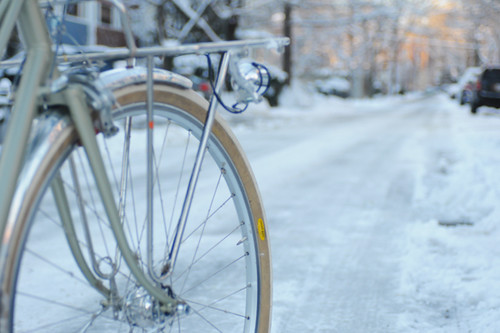

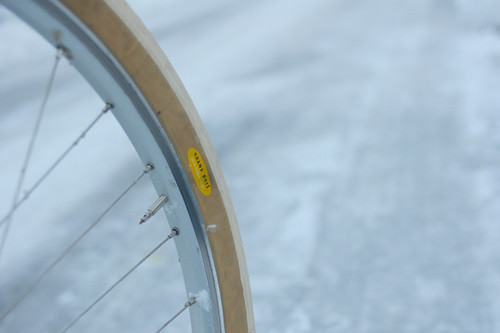
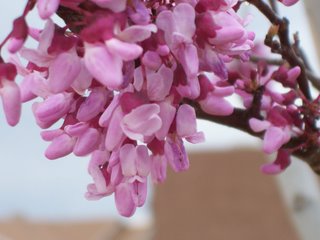
 Yellowstone National Park, July 1979
Yellowstone National Park, July 1979 Bottom of page 47 in Columbiana County, Ohio deed book 9from microfilm 926865 at the Family History Library, Salt Lake CityJohn Ruppard and Andrew Richard Ruppard selling land to Durs Walser(As always, double-click on the images to view a larger version.)
Bottom of page 47 in Columbiana County, Ohio deed book 9from microfilm 926865 at the Family History Library, Salt Lake CityJohn Ruppard and Andrew Richard Ruppard selling land to Durs Walser(As always, double-click on the images to view a larger version.) Page 48 in Columbiana County, Ohio deed book 9
Page 48 in Columbiana County, Ohio deed book 9 page 48 in Columbiana County, Ohio deed book 9Signatures of John (in “German”), Andrew Richard, Mary, and Barbery Rupert/Rupard
page 48 in Columbiana County, Ohio deed book 9Signatures of John (in “German”), Andrew Richard, Mary, and Barbery Rupert/Rupard“John Rupert, a German, who upon his arrival in Baltimore from Germany, being unable to pay his passage money, was sold by the captain of the vessel to a person who, in consideration of receiving Rupert's services free for the ensuing three years, paid the captain's demand. Rupert lived in Hanover until his death, after reaching the age of one hundred years. The farm he owned is now owned by C. Pfeffer, in section 26, Hanover twp.”But just as interesting was the fact that John Ruppard had obtained the land by Patent. A quick search of the patent records at the BLM Website using his last name, as well as variations, brought up nothing. A search for township 15, range 4, section 26 displayed three entries – for the NW 1/4, the NE 1/4, and the SE 1/4. That was a bit confusing. What happened to the SW 1/4?
 Page 649 in Columbiana County, Ohio deed book 33David Ehrhart & Conrod Yarian executors of John RupartSelling land to William Ehrhart
Page 649 in Columbiana County, Ohio deed book 33David Ehrhart & Conrod Yarian executors of John RupartSelling land to William Ehrhart Page 650 in Columbiana County, Ohio deed book 33
Page 650 in Columbiana County, Ohio deed book 33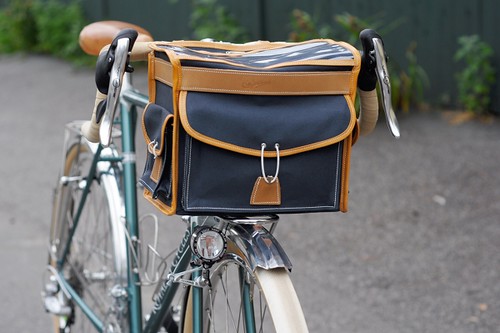 I finally received a Giles Berthoud handlebar bag for the Randonneur. It's the Model 25 in gray, which is their medium size and features elastic ties for the pockets instead of leather straps.
I finally received a Giles Berthoud handlebar bag for the Randonneur. It's the Model 25 in gray, which is their medium size and features elastic ties for the pockets instead of leather straps. The visual presence of this bag is almost too much for me. There is something about its colour scheme and construction that says "I am French and I am exquisite," and I find this both interesting and intimidating.
The visual presence of this bag is almost too much for me. There is something about its colour scheme and construction that says "I am French and I am exquisite," and I find this both interesting and intimidating.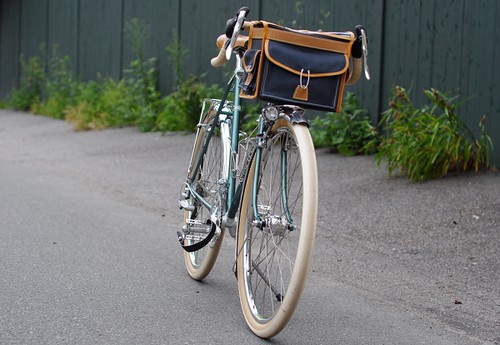 But happily, the Berthoud does not overwhelm the aesthetics of the bicycle. The size is a perfect fit. And the darker fabric and lighter leather combination parallels the contrast between the frame and lugwork. In comparison, the Ostrich handlebar bag on my own bike is more drab and also more bulky.
But happily, the Berthoud does not overwhelm the aesthetics of the bicycle. The size is a perfect fit. And the darker fabric and lighter leather combination parallels the contrast between the frame and lugwork. In comparison, the Ostrich handlebar bag on my own bike is more drab and also more bulky.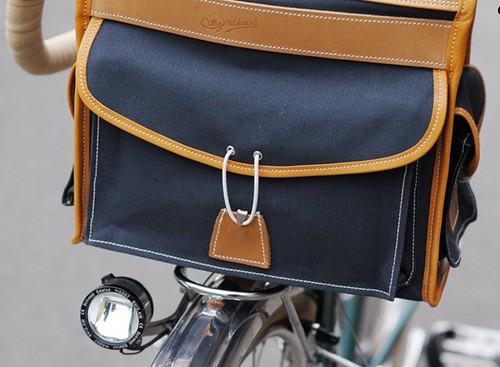 The bag has a large front pocket,
The bag has a large front pocket,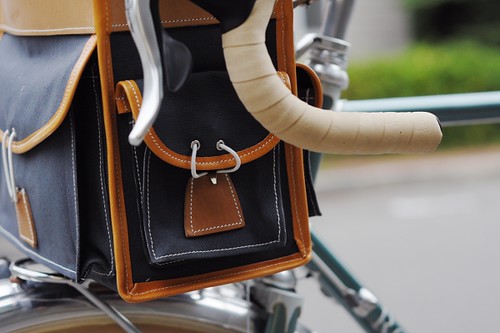 two side pockets
two side pockets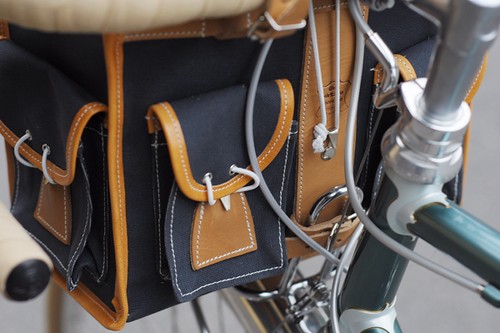 and two rear pockets. The top flap closes toward, rather than away from the cyclist, which is the opposite of what I am used to with the Ostrichand makes it counterintuitive for me to use - but this is of course user-specific. You can see that leather straps are provided for wrapping around the back of the rack. However, there are no provisions for securing the bag to the rack's platform, which surprised me (Ostrich includes straps for this). I know that some devise DIY systems, and if you've done so I'd love to hear about your process.
and two rear pockets. The top flap closes toward, rather than away from the cyclist, which is the opposite of what I am used to with the Ostrichand makes it counterintuitive for me to use - but this is of course user-specific. You can see that leather straps are provided for wrapping around the back of the rack. However, there are no provisions for securing the bag to the rack's platform, which surprised me (Ostrich includes straps for this). I know that some devise DIY systems, and if you've done so I'd love to hear about your process.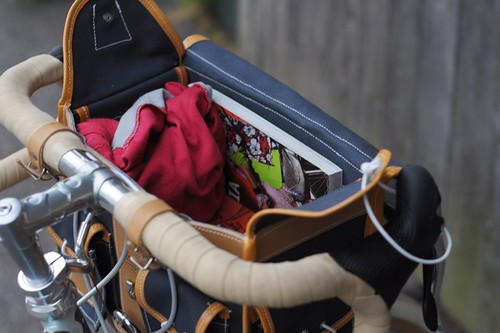 There are leather straps provided for attaching the bag to the handebars, though most opt for installing a decaleur. And here is where we are experiencing a little glitch. Ideally, the owner would prefer to forgo a decaleur: He plans to ride both with and without the bag, and a bagless decaleur sticking out of the bicycle doesn't look great (I agree). The handlebar straps hold the bag up fine, but without being secured on the bottom it bounces on the rack when filled with stuff and going over bumps. I am also told that the bag can move from side to side without a decaleur, though I haven't experienced thisyetduring my one test ride so far(with 10lb of weight in the bag).
There are leather straps provided for attaching the bag to the handebars, though most opt for installing a decaleur. And here is where we are experiencing a little glitch. Ideally, the owner would prefer to forgo a decaleur: He plans to ride both with and without the bag, and a bagless decaleur sticking out of the bicycle doesn't look great (I agree). The handlebar straps hold the bag up fine, but without being secured on the bottom it bounces on the rack when filled with stuff and going over bumps. I am also told that the bag can move from side to side without a decaleur, though I haven't experienced thisyetduring my one test ride so far(with 10lb of weight in the bag). As far as decaleurs go, we had planned to use one of theseif going without proved impossible, but I have since been warned that using it with the Nitto lugged stem (as opposed to the regular Technomic stem) is not a good idea, for complicated reasons related to clamp compatibility that I won't go into here. An alternative would be Berthoud's own decaleur, but it too apparently presents issues with the lugged stem - plus it is fairly obtrusive without the bag on. A headset-mounted decaleur is not possible here, because it would sit too low. So I am seeking a solution, and also wondering whether securing the bag at the bottom would in itself solve the problem. The bag is not nearly as large as my Ostrich, and I know that some do manage to use it without a decaleur. Sharing of experiences in this regard would be most appreciated.
As far as decaleurs go, we had planned to use one of theseif going without proved impossible, but I have since been warned that using it with the Nitto lugged stem (as opposed to the regular Technomic stem) is not a good idea, for complicated reasons related to clamp compatibility that I won't go into here. An alternative would be Berthoud's own decaleur, but it too apparently presents issues with the lugged stem - plus it is fairly obtrusive without the bag on. A headset-mounted decaleur is not possible here, because it would sit too low. So I am seeking a solution, and also wondering whether securing the bag at the bottom would in itself solve the problem. The bag is not nearly as large as my Ostrich, and I know that some do manage to use it without a decaleur. Sharing of experiences in this regard would be most appreciated.